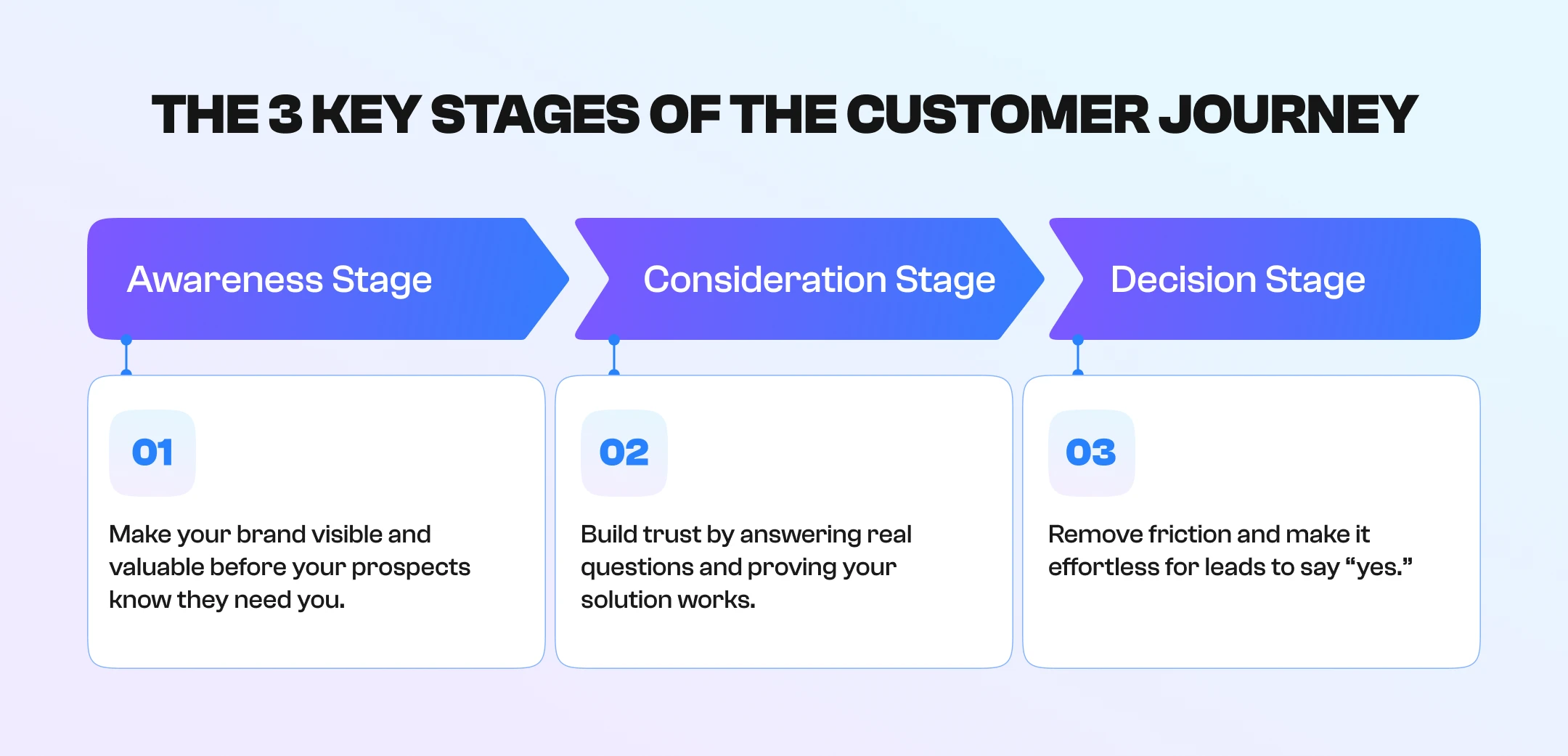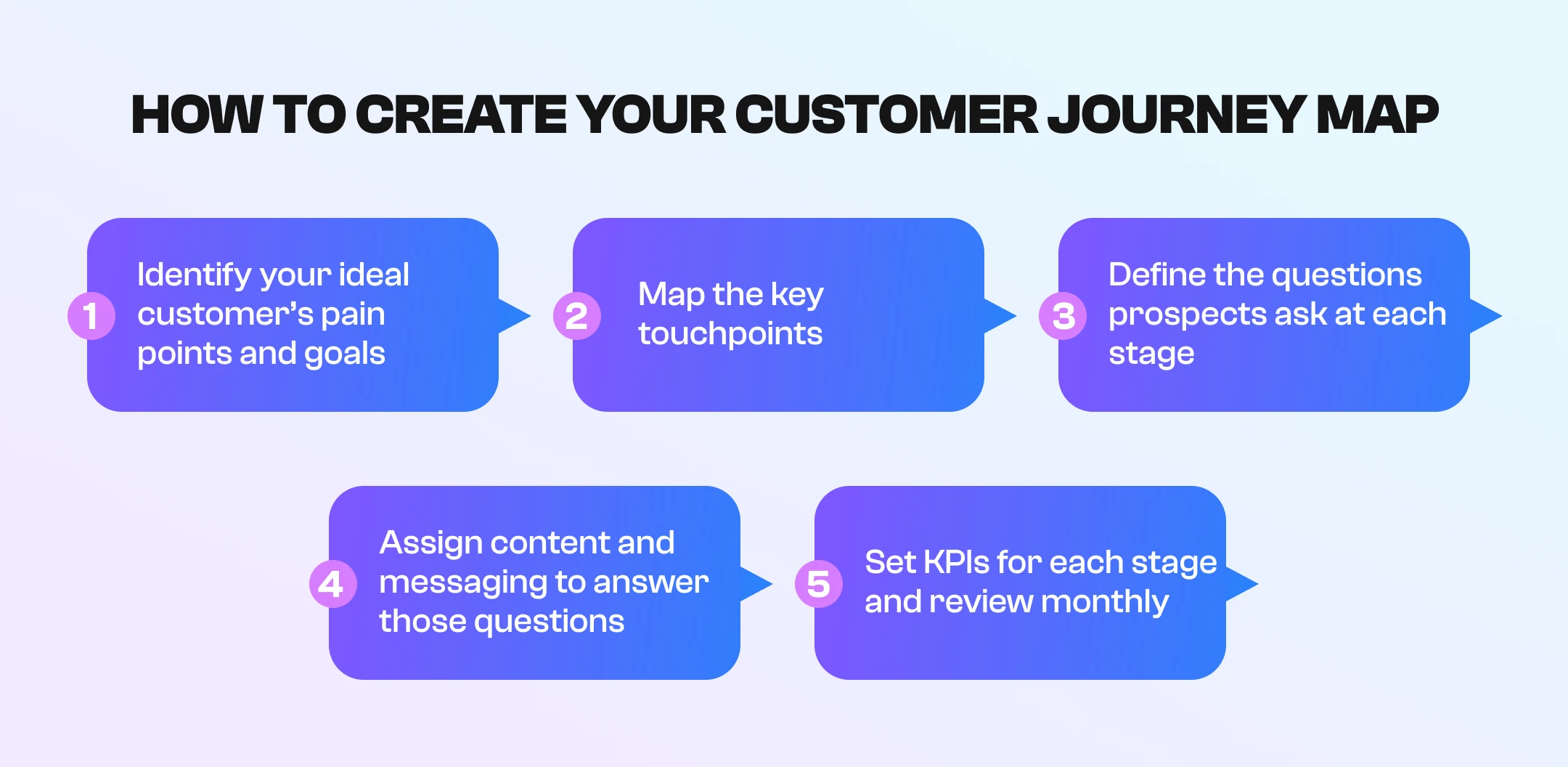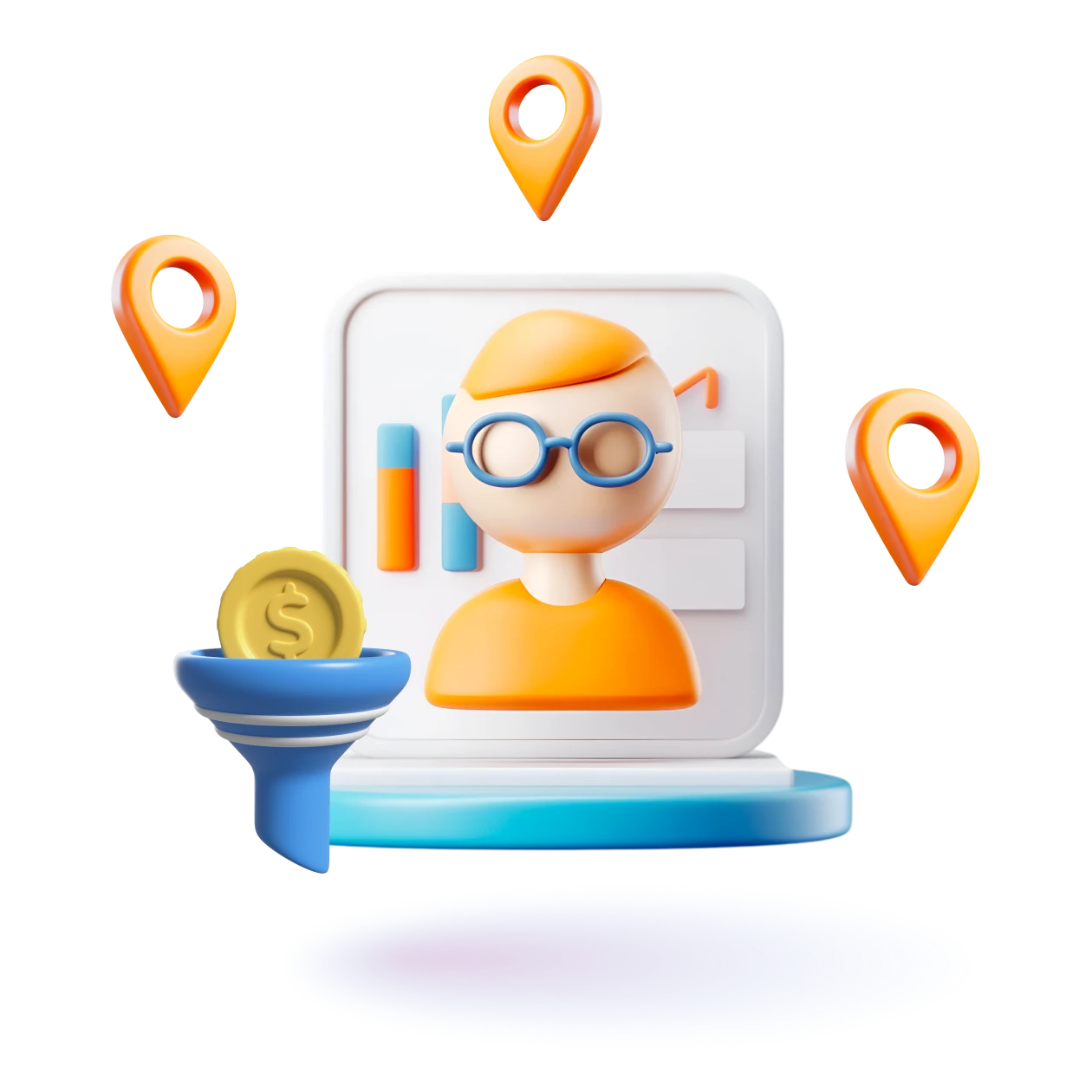Let me tell you about a client we worked with at SalesAR not too long ago. They came to us frustrated—running LinkedIn campaigns here, cold emails there, and PPC ads on top—but their pipeline was a mess. They couldn’t figure out why some leads disappeared after the first reply, others ghosted after a demo, and some quietly dropped off the radar.
That experience made me step back and rethink how we map customer journeys at SalesAR. The customer journey lead generation journey isn’t just about pushing messages out and hoping something sticks—it’s about understanding each touchpoint.
It’s about seeing the full picture—understanding where each lead starts, what makes them curious enough to click, and what ultimately gets them to sign. Without that, you’re not generating leads—you’re just making noise.
- What is a Customer Journey Lead Generation Strategy?
- Why Most Companies Get It Wrong
- The 3 Key Stages of the Customer Journey
- Data: The Missing Link in Most Lead Generation Journeys
- Personalization and Consistency—The Glue That Holds the Journey Together
- Measuring What Matters—Metrics for Each Stage
- How to Create Your Customer Journey Map—SalesAR’s Framework
- Conclusion
What is a Customer Journey Lead Generation Strategy?
The customer journey is every step a prospect takes from the moment they realize they have a problem to the point they sign the contract (and even beyond that). In lead generation, this journey starts long before your sales team makes the first call. It begins when someone searches for a solution, sees a helpful post on LinkedIn, or opens your email because the subject line hits a nerve.
When you understand your lead generation journey, you stop guessing and start guiding prospects with intent. You know which questions your leads ask at each stage, what objections pop up, and what kind of content helps them make decisions. Conversion rates can jump as much as 200% for companies that get this right.
Why Most Companies Get It Wrong
At its core, the customer journey is a prospect’s path from the first time they realize they have a problem signing a contract (ideally, becoming a loyal customer). It’s not a single moment—it’s a series of steps, decisions, and impressions that shape how they see your brand.
The problem? Most companies only focus on two moments: the first touch (that cold email, LinkedIn ad, or SEO blog that catches attention) and the final close (the signed deal). Everything in between—the research phase, the internal debates, the objections and doubts—gets ignored. But that’s precisely where trust is either built or lost.
“A lead doesn’t convert because of a single email or ad. It’s the sum of every impression, every piece of content, and every unanswered question they encountered along the way.”
And here’s the proof. According to HubSpot, 87% of buyers say a consistent experience across online and offline channels is critical to their decision-making process.
In other words, if your lead reads one thing on your website, hears another from your sales team, and gets a third version in your follow-up email, you’ve already lost them. A mapped, consistent customer journey keeps every step connected—so your prospects feel on a clear path, not wandering through a maze.
The 3 Key Stages of the Customer Journey
A successful lead generation journey helps prospects move from curiosity to commitment—one relevant touchpoint at a time.

Awareness Stage—Planting the Seed
Let me share a quick story. A SaaS client came to us complaining about poor cold email open rates. Their team was convinced the subject lines were the issue. After we stepped back and mapped their customer journey, the real problem became obvious—their prospects had never heard of them. There was no awareness, trust, or reason to open the email.
We reworked their entire approach. Instead of jumping straight into sales outreach, we launched brand awareness campaigns across LinkedIn and industry forums. We also had their leadership team post thought leadership content—not sales pitches, just useful insights that got their name out there. Only then did we go back to cold outreach. The result? Open rates jumped by over 60% because prospects finally knew who they were.
The lesson is simple: If they don’t know who you are, your pitch doesn’t matter. That’s especially true in B2B, where 95% of buyers aren’t actively in-market when they first see your brand. You’re too late if you only show up when you want something from them. The Awareness Stage is where you build familiarity and trust, long before you ask for a call.
Consideration Stage—Building Trust
Many companies stumble at this stage, including one fintech client we worked with at SalesAR. Their sales team assumed every lead wanted to book a demo immediately, so every follow-up was the same: “When can we schedule a call?”
But after mapping their customer journey, we saw a clear gap. Most leads didn’t feel ready for a demo because they didn’t fully understand the product’s value. They wanted proof that this solution worked—real examples, clear comparisons, something that answered “Why you?” before they gave up their time.
We built a nurture campaign designed to do precisely that. Every lead received content tailored to their industry and pain points—case studies from similar companies, side-by-side competitor comparisons, and customer stories showing real results. By the time sales reached out again, the leads already had answers to the most common objections. Demo bookings went up, and calls started with, “I saw that case study you sent—that’s exactly what we need.”
The big takeaway is that a leader isn’t a decision-maker until they trust you can solve their problem.
And the data backs this up—47% of buyers view 3-5 pieces of content before they’re willing to talk to sales. You’re not nurturing leads if your lead-generation process skips this trust-building step. You’re just pushing for a “yes” before they’re ready.
Decision Stage—Removing Friction
This stage should be the easiest, but it was the biggest headache for one of our clients. They had strong awareness and solid nurture campaigns, and leads showed genuine interest. But right at the finish line, deals kept stalling. Some went dark, and others asked for more time to “think it over.”
When we dug into their process, the problem was crystal clear: the pricing page was vague, and the call to action was buried under too much fluff. Prospects weren’t sure what would happen after they said “yes.” That uncertainty created friction, and friction kills momentum.
We made two quick changes: We simplified their CTA (“Start your free trial—no credit card needed”) and made pricing completely transparent. We also added a handful of fresh testimonials, so leads saw proof that others in their industry were already succeeding with the product.
That simple shift led to a 35% jump in conversions.
The lesson? The easier you make it to say ‘yes,’ the faster leads convert.
Data: The Missing Link in Most Lead Generation Journeys
Every lead tells a story—if you know where to look. But here’s the problem I always see: most companies only listen to the loudest voices. They track the first click and celebrate the final sale, but everything in between? That part gets ignored.
What happens after someone opens your email but doesn’t reply? What content do they read before booking a demo? How many times do they check your pricing page before reaching out? These moments—the quiet signals—are where the real story unfolds.
The way to capture that story is simple: unify your data. Bring together email engagement, social interactions, website visits, CRM notes, and even call transcripts into one place. Whether you use a Customer Data Platform (CDP) or a solid reporting tool, the goal is the same—see the full journey, not just isolated events.
At SalesAR, we also obsess over tracking where leads drop off and how much time passes between key touchpoints. When you can spot these patterns, you don’t just see what’s working—you see exactly where trust is breaking.
This isn’t just theory. Companies using data-driven personalization see a 5- 8x ROI on their marketing spend. That’s because they’re not guessing what leads want—they’re reading the story their leads are already telling them.
Want to experience it for yourself? Book a strategy call with SalesAR.
Or, if you’re just starting out, download our free PDF on reducing lead acquisition costs and take the first step toward a smarter funnel.
Download our free PDF guide with proven cold email strategies — including subject lines that get opened, messages that convert, and CTAs that drive real engagement.
Personalization and Consistency—The Glue That Holds the Journey Together
One of the most avoidable mistakes I’ve seen—and fixed—is the disconnect between marketing and everything that follows. A healthcare tech client spent a fortune on gorgeous LinkedIn ads. They were creative, on-point, and getting clicks. But the second those leads landed on the website, they left.
Why? The landing page sounded like a completely different company. The tone, message, and value proposition did not match what the ad promised. That disconnect instantly broke the flow of trust.
We worked with them to align everything: ad messaging, landing page content, email follow-ups, and sales call scripts. Every touchpoint felt like part of the same conversation. The result? 28% higher conversions—just by ensuring leads weren’t wondering, “Wait, is this the same company?”
I can’t stress this enough: the goal isn’t just to get noticed—to feel familiar and reliable at every step.
Personalization makes that even stronger. When you tailor your outreach based on what leads have seen, clicked, or asked about before, you’re not cold pitching—you’re continuing a conversation.
Consistent, personalized journeys aren’t just smoother—they make leads feel like you know them. And that’s how trust turns into deals.
Measuring What Matters—Metrics for Each Stage
One of the biggest mistakes I see over and over is companies only measuring the finish line—closed deals. Of course, revenue matters, but if that’s the only number you’re tracking, you’re flying blind. Most real problems—the ones quietly killing your pipeline—appear much earlier in the customer journey. Small cracks in the Awareness or Consideration stages turn into massive leaks by the time you’re trying to close.
That’s why at SalesAR, we track metrics for every stage—not just to measure performance but to spot problems before they snowball.
Here’s the breakdown I recommend:
- Awareness Stage: How many people are seeing you? Track reach, impressions, and initial response rates (like open rates for cold emails or engagement on LinkedIn posts).
- Consideration Stage: How many are digging deeper? Look at content downloads, webinar registrations, and reply rates to follow-ups.
- Decision Stage: This is where intent turns into action. Track demo bookings, proposal requests, and close rates—and ensure you know precisely why deals are lost.
A more significant reason to get this right is that companies with fully aligned sales and marketing reporting generate 208% more revenue.
Alignment isn’t just about teams getting along—it’s about both sides working from the same data, so sales know precisely where a lead came from and marketing knows what happens after the first touch. When everyone tracks the whole journey, not just their piece, the results speak for themselves.
How to Create Your Customer Journey Map—SalesAR’s Framework
You need a lead generation customer journey map to stop guessing your leads’ needs and guide them through a process that builds trust. At SalesAR, we use a simple framework to do this for our clients, and it works for companies of any size and in any industry.

“Your map is a living document—update it every time you learn something new about your prospects.”
Markets shift, needs evolve, and competitors change their tactics. The best lead generation customer journey maps aren’t set in stone—they evolve with every insight, campaign, and closed deal.
If you build your customer journey with this framework, you’ll immediately see the difference. Your outreach will feel more relevant, your leads will move through the funnel faster, and your sales and marketing teams will finally speak the same language.
Conclusion
Let me wrap this up with one last story. Without a clear lead generation journey, you’re not guiding—you’re guessing. Focus on the right message at the right time instead of treating every lead like they were ready to buy.
When you approach it as a customer journey lead generation process—mapping, personalizing, and tracking what matters—everything starts to click.
The best lead generation feels effortless—because it’s built with the lead’s journey in mind.
If you’re ready to see how this works for your business, book a consultation with SalesAR—and let’s map your customer journey together.
No cold outreach, no stress. Just sales-ready calls with decision-makers.


